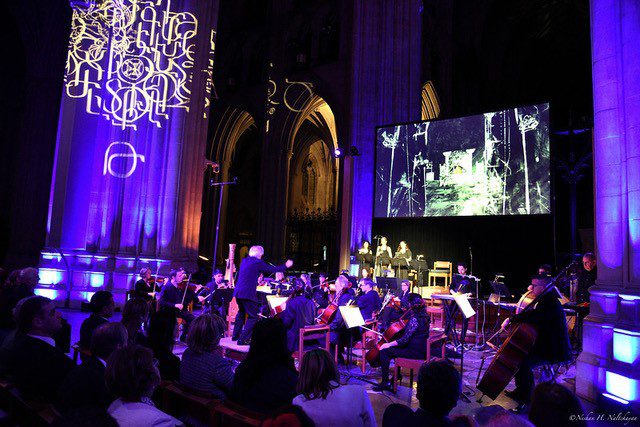PostClassical Charts ‘An Armenian Odyssey’
By • March 12, 2020 0 1760

PostClassical Ensemble was lucky. “An Armenian Odyssey: The Color of Pomegranates,” the chamber orchestra’s major spring production, preceded — barely — the ban on public gatherings intended to slow the spread of COVID-19.
Apart from any then-unknown health risks, which we hope were minimal, the audience of two or three thousand, including a large subset of D.C.’s Armenian American community, was lucky too. Because the concert, presented on March 4 at Washington National Cathedral, was a powerful, moving and musically exquisite experience.
Overseen by executive director Joseph Horowitz and music director Angel Gil-Ordóñez, who co-founded the “experimental orchestral laboratory” in 2003, the event was part of a mini-festival of music and film marking the 100th anniversary of Armenian-American diplomatic relations. As such, it opened with brief remarks by Ambassador Varuzhan Nesesyan of the Republic of Armenia and Marie Royce, assistant U.S. secretary of state for educational and cultural affairs.
The 90-minute musical program, without intermission, consisted of a single piece, a world-premiere commission from Armenian composer Vache Sharafyan, who has been an official composer for Yo-Yo Ma’s Silk Road Project since 2001.
The two dozen PostClassical regulars were supplemented by Zulal, an Armenian American vocal trio; 31-year-old Armenian cellist Narek Hakhnazarian, a gold medal winner at the 2011 International Tchaikovsky Competition; and two Armenian masters of the duduk, an ancient double-reed instrument made of apricot wood: Jivan Gasparyan, aged 91, and Jivan Gasparyan Jr.
PostClassical is known not only for thematic, cross-cultural programming but for performances incorporating other media. For “An Armenian Odyssey,” a large screen was suspended over the musicians. On it (and on smaller screens placed along the tremendous nave on both sides), images created by Armenian-Syrian artist Kevork Mourad to correspond to the music were projected. There were also projections of colored light and patterned slides on the columns, arches and ceiling of the nave.
“An Armenian Odyssey” was in two parts: “Homage to Sayat-Nova” and “Diaspora and Rebirth.” The second part, featuring Hakhnazarian, was Sharafyan’s Second Cello Concerto, written in 2013.
Sayat-Nova (1712-1795) is Armenia’s national bard. Born in Tbilisi, now the capital of the Republic of Georgia, he wrote, composed and sang in Armenian, Persian, Georgian and Azeri. Unfortunately, none of his lyrics was shared in English at the event. Here is the opening of a poem or song, as translated by Alice Stone Blackwell: “I beheld my love this morning, in the garden paths she strayed,/All brocaded was the ground with prints her golden pattens made.”
Audience members unfamiliar with Sayat-Nova were introduced to him, at least in outline (pun intended). As depicted in Mourad’s drawings, the bard fell in love with a princess, was banished from the Georgian court, became a priest, settled at Haghbad Monastery and, in his 80s, was beheaded for refusing to convert to Islam.
The music began with a grandfather-and-grandson duduk duet lasting several minutes. The nave of the cathedral, where PostClassical is ensemble-in-residence, is not acoustically ideal for some musical genres, but for this instrument — a cross between an oboe and, when played in tandem, bagpipes — it was perfect; the sound was haunting, timeless and vaguely Eastern (also a Eurocentric term, but preferred to Oriental).
This mood continued, heightened by the use of cymbals, drums, bells and gong, the precise and pleasing vocalists of Zulal — who sang with and without words and later played ocarinas — and the always excellent orchestra under Gil-Ordóñez’s fluid conducting.

Armenian American vocal trio Zulal switches to ocarinas. Photo by Neshan H. Naltchayan. Courtesy PostClassical.
Solos by concertmaster Netanel Draiblate, oboist Fatma Daglar and trumpeter Chris Gekker, among the area’s top instrumentalists, frequently caught the ear as the music progressed. Though he was not positioned at the front of the stage, Hakhnazarian, on a raised platform at center during the second half, made his cello sing out, especially in the many passages written in a high register.
How to describe Mourad’s illustrations, which he refers to as “live and pre-animated drawing”? At different times, they remind one of Javanese shadow puppets, of children’s book illustrations, of Edward Gorey’s line-drawings, of South African artist William Kentridge’s animations. That they paired with the music so seamlessly was remarkable. While absorbing the music, one’s attention was fixed on the images. Backgrounds evolved, figures shifted, scenes changed as if a camera was panning. Most striking were the segments of live drawing, when the huge, blurred hand of the artist appeared on the screen.
A few moments (as best I can recall and interpret them) to give you an idea: In “Homage to Sayat-Nova,” the puppet-like figure of the bard “walks” across a courtyard and kneels before the princess, a blue figure in an upper window, and the courtyard fills with townspeople. Later, an orange fire burns in a fireplace as the lovers dance and a window curtain flutters in the breeze. In the “Diaspora and Rebirth” section, the genocide is depicted with a blue wash of massacred figures and smoke rises in a black sky from burning churches. Depicting the “Velvet Revolution” of 2018, in a large plaza with a golden statue in the center, dozens of arms are raised under a yellow-orange sky.
Next spring, there will be another opportunity to see a collaboration between PostClassical Ensemble and Mourad in D.C., when Manuel de Falla’s “Master Peter’s Puppet Show” will be presented with his visuals, a production seen earlier in New York, where Mourad now lives.
PostClassical’s “Cultural Fusion: The Gamelan Experience,” in which two gamelan orchestras participated — demonstrating the influence of the Indonesian genre on European and American composers — was named the best classical music event of 2019 by Washington Classical Review. Though that performance was truly a unique spectacle, “An Armenian Odyssey” matched it as an audience-pleasing expression of the ensemble’s commitment to its brainy, innovative and labor-intensive path.

